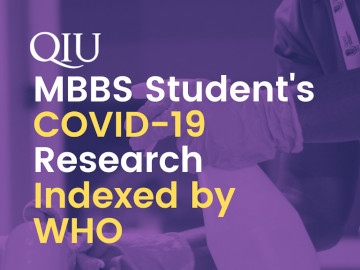- Third-year MBBS student Shermaine Yee has medical hypothesis paper on COVID-19 myth indexed by Tier 1 medical journal and World Health Organisation (WHO)
- She co-authored the article with four experienced academics—a stellar achievement for a student.
- Second article co-authored with MBBS classmate Wen Han Chooi also published in a renowned journal
Since COVID-19 changed our world, there’s one conspiracy theory that just won’t go away—was this deadly virus made by humans and sent out for nefarious purposes?
Well, we’re proud to say that our medical student Shermaine Yee has researched a possible answer. And her answer has been indexed as a resource by none other than the World Health Organisation!
Shermaine, a third-year MBBS student, saw her paper published in the Journal of Medicine and Life—a Tier 1 medical journal indexed by SCOPUS, the largest abstract and citation database of peer-reviewed literature.
But wait, we’ve teased the answer long enough. Was this virus actually man-made? Here’s what Shermaine’s research indicates:
“Specific features observed in SARS-COV-2 helps scientists to rule out the idea that this pandemic caused by the novel coronavirus is the result of a man-made action that could be either engineered in the laboratory or further created as a bioweapon out of conspiracy,” explained Shermaine.
“Recent discoveries revealed evidence of the presence of the virus around the world before it emerged in Asia. There is growing evidence of its true origin as a global organism that was waiting for favourable conditions to emerge instead of originating in China.
“Testing of sewage in Barcelona had suggested that the virus may have been present in the Spanish city in March 2019, many months before China identified the pathogen in the city of Wuhan in December 2019.”
Shermaine said she was interested in the topic because everyone was curious about the origin of this virus. Her hope is that the article would provide a direction for more researchers to explore the virus’ origin and the reasons behind its emergence.
“It was one of the best moments in my life. I’m still new in this field and I never thought that this article would be able to be published in a Tier One SCOPUS-indexed journal. It feels like the team’s hard work finally paid off. In addition, it also inspired and motivated me to continue to learn more about research so that I can contribute more in this field,” she added.
This wasn’t the only publication Shermaine was involved in, as she co-authored another article with her fellow MBBS coursemate Wen Han Chooi, titled “COVID 19: The safety profile of common disinfectants used for sanitization”
“With the recent outbreak of COVID-19, sanitisation is a must for the community as a form of daily safety prevention. But when misused, hand sanitisers can be toxic to human health and the environment.”
I’m really excited that this paper passed the peer-review process and finally accepted by the journal. It has given me a sense of accomplishment of the hard work of the team and I learned a lot throughout this journey,” he said.
Both Shermaine and Wen Han thanked the University and the academics for supporting them, as well as the journal editors who gave their article a chance.
All of us at QIU couldn’t be prouder. Congratulations to both the budding doctors for their incredible contributions at such a young age!


